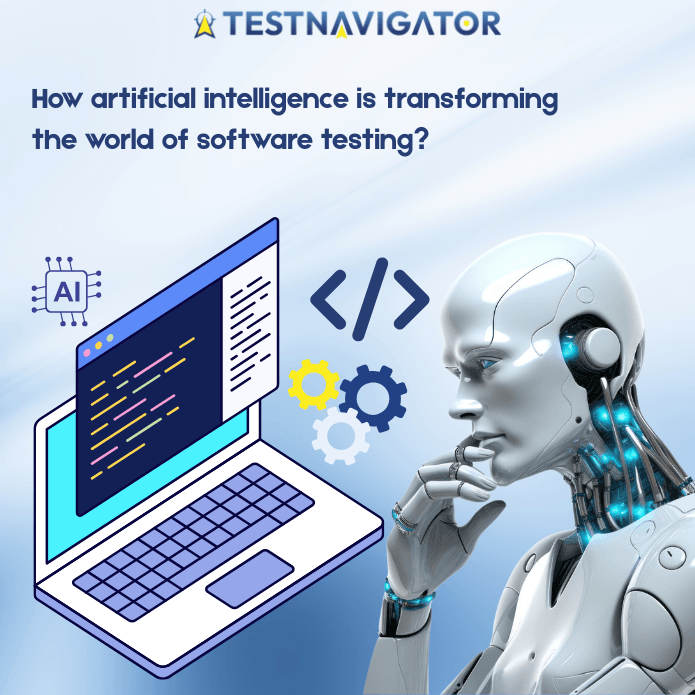
We have grown used to the fact that technology today is advancing at an almost incomprehensible speed – and artificial intelligence is a prime example of this rapid progress. As we can see in more and more areas, this exciting technology is also becoming increasingly widespread in the world of software testing. Those who fall behind in adopting it can easily lose ground to competitors. But how exactly can AI support software testing?
In what ways can it help?
1. Test case prioritization
In a modern software development project, test suites can often grow to enormous sizes, and running every single test becomes an extremely time- and cost-intensive process. In fact, expecting full test coverage after every code change in large systems is often unrealistic. When time is tight, the areas with the highest risk must take priority. This is where an AI-powered test case prioritization tool can be invaluable: it can identify code changes, past bug reports, and the business importance of features. Based on this, it automatically ranks the test cases, allowing the team to focus first on the most problematic parts. This not only saves time but also reduces the risk of releasing critical bugs into production.
2. Measuring test coverage – More than just a percentage
Test coverage metrics are useful indicators of a software’s current state, but they don’t necessarily tell the full story of its quality. AI can go much deeper: it can highlight which parts of the codebase have been left untested and where the highest risks lie. For instance, a module may show 80% coverage, but the most critical 20% might remain untested. AI identifies these blind spots, turning coverage into more than just a number – it becomes a real guarantee of quality.
3. Managing test cases – From chaos to order
At large enterprises, it’s not uncommon to have tens of thousands of active test cases, and keeping them maintained and organized is an enormous challenge. With this scale, chaos can quickly emerge: outdated test cases, duplicates, or irrelevant items that no longer match the current development environment. These not only reduce efficiency but also distract teams from addressing real issues. AI provides crucial support in this situation: it intelligently categorizes and organizes tests, automatically filters out duplicates, flags outdated cases, and keeps the entire test suite up to date. As a result, companies always work with a well-structured, maintainable, and relevant testing environment. Instead of wasting hours or even days on administrative work, teams can devote their freed-up time to real value creation: identifying bugs faster, improving quality, and continuously enhancing the customer experience.
4. Code change detection – Regression testing
When a developer modifies code, it is often difficult to determine exactly how it will affect the system as a whole and which parts of the code should be retested to catch potential errors. Regression testing is critical, but rerunning the entire test suite can consume enormous amounts of valuable time. AI can assist here as well: it analyzes code changes and helps automate the regression testing process. This requires far less time and resources than executing the full suite. The result: faster releases with fewer defects.
Staying ahead of the competition
Artificial intelligence is no longer science fiction. A striking example is Google DeepMind’s Gemini model, which recently achieved gold-level performance at the ICPC World Finals, one of the most prestigious programming competitions in the world. The system solved complex tasks that even the most skilled human software testing teams found highly challenging. This clearly demonstrates that AI not only supports testers but is also capable of competing at the very forefront of the IT world. Ignoring its potential could mean falling behind.
Should we be worried?
Many fear that artificial intelligence will eventually replace software testers. In reality, AI doesn’t replace human work – it complements it. While it is highly effective in processing large volumes of data, prioritizing tests, or quickly identifying regression errors, there are still areas where the human eye and experience are indispensable. Recognizing edge cases, testing user experience (UX), or evaluating design elements require creativity, empathy, and intuition – qualities that AI cannot replicate. Ethical and business considerations also demand human judgment. AI is therefore a powerful tool that provides immense support to testers, but the final responsibility for quality assurance remains in human hands.
A symbiotic future?
Artificial intelligence is no longer an experimental toy but one of the driving forces of modern software testing and development. It can automate repetitive tasks, make processes faster and more transparent, and elevate bug detection to a new level. At the same time, human creativity, intuition, and empathy remain essential. The question for the future is not "AI or humans," but rather how AI and humans can work together seamlessly. The most successful teams will be those that recognize this symbiosis early and know how to harness the advantages AI has to offer.